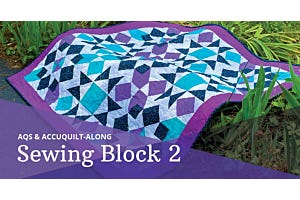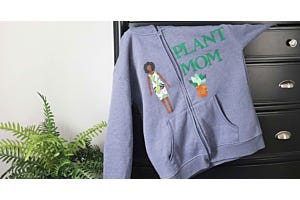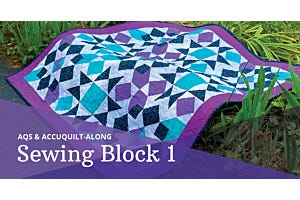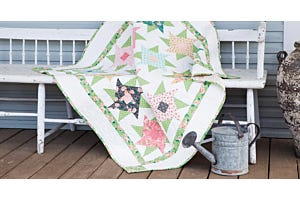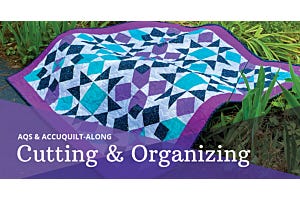-2.jpg)
What happens when a quilter and knitter walk into a bar? They leave it together for the journey of a lifetime. Or that was the case for new AccuQuilt GO! Getter Chip Connor and Aaron Brown.
This perfect pair met in 2008 in Seattle. Together, they host the Fiber Hustle podcast and YouTube channel which combines Chip’s love of quilting and Aaron’s passion for knitting into one wholesome platform. It even includes virtual Bingo!
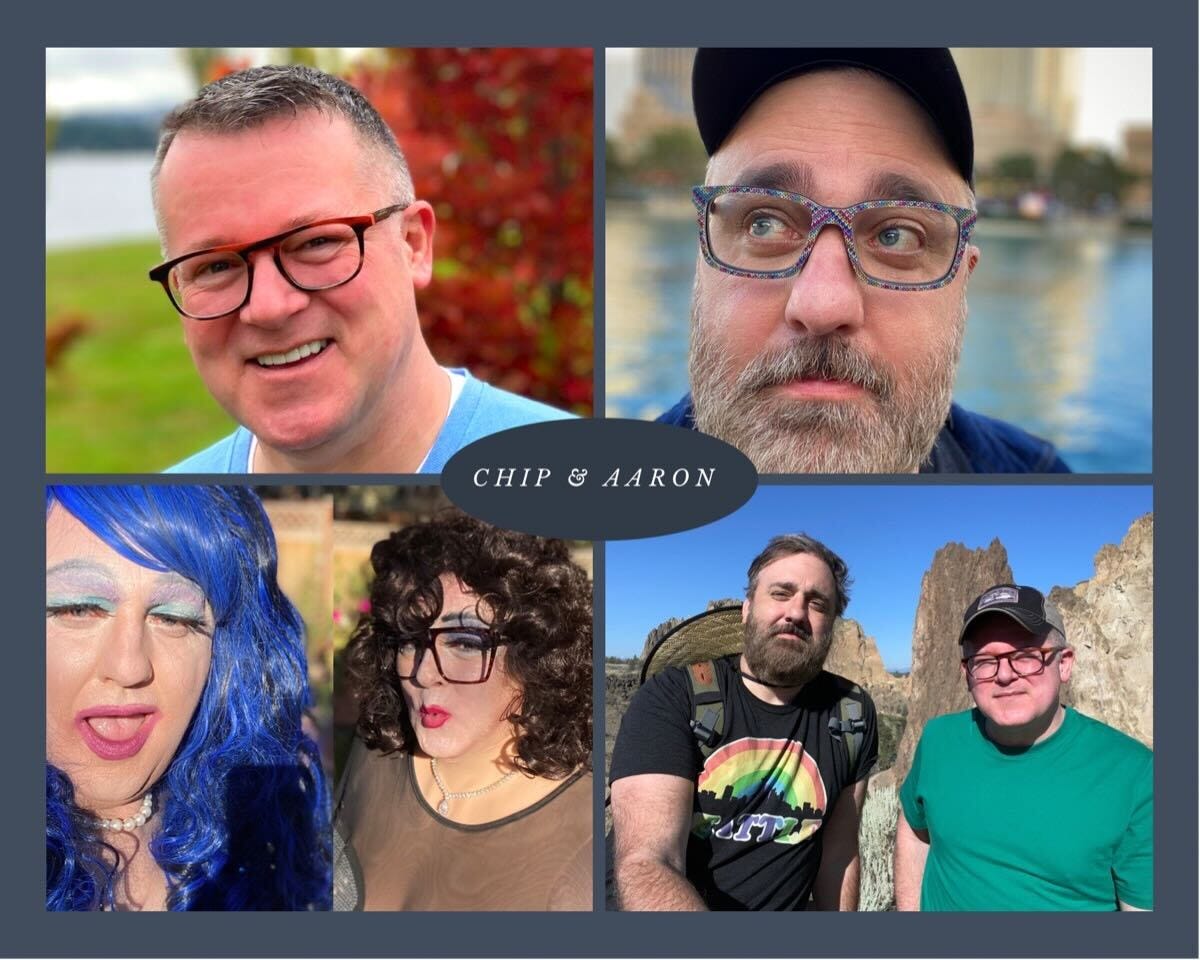
The Perfect Pair: A Creative Duo
In the spirit of perfect pairings, we were compelled to get to know this dynamic duo even better. Check out our interview below to learn all about Chip and Aaron - including what inspires them and how their ideas manifest into finished projects!
AccuQuilt: Chip and Aaron, thank you for taking the time to let us get to know you better! To kick us off, what makes you both the perfect pair?
Aaron: We’re still learning that one, but we balance each other out.
Chip: Aaron is an extrovert and I’m more introverted. People just naturally gravitate to Aaron because he’s an adventurous peacekeeper. He likes to get out and explore new places, whereas I’m the comedian who’s really a hermit. I like to hang out with people on Zoom occasionally, but I'm happiest being a homebody.
A: Also, Chip is better at making quick decisions, whereas I feel more comfortable checking out all my options first.
C: Very true! No matter if it’s trying to decide on dinner or the next vacation…it will be a lengthy process! I’m like, “Let’s just get pizza!” But what makes us click is that we’re able to talk things through by processing our different viewpoints, and we like to make each other laugh a lot.
AQ: Chip, you’re a new GO! Getter at AccuQuilt with a passion for quilting, of course, but you also have a background in making garments. What made you interested in picking up quilting, and how did you get hooked?
C: Making my own garments was my intro to sewing, and I really did enjoy myself. But looking back, I was never comfortable taking risks with anything I would potentially wear. I found myself buying “safe” fabrics and making clothes similar to what you’d find in stores. Invariably, after all that work, I wound up feeling bored. It’s like spending hours making homemade mushroom soup and then it tastes like…mushroom soup!
Now that I’ve been at it for a number of years, I can easily say quilting is my art form and each design is a new possibility. It’s just so liberating! Pro-tip: there’s no such thing as a new idea. The wheel already exists, so what can we do with it?
I’m always thinking about this question when I find myself captivated by an amazing piece of art. How can I borrow from this inspiration and push this concept into a new direction? It’s this process and potential that has me hooked on quilting, and without being cheesy… every day is another opportunity to try something new.
AQ: Aaron, your love lies with fiber arts and knitting. What got you started with the craft and what kind of projects do you enjoy making the most?
A: After I got Chip his first sewing machine, we of course found ourselves at many fabric and quilt stores. For some reason, sewing never caught my eye, but one day while at a fabric store in Portland, I found myself in the knitting section. I saw all this gorgeous yarn. I wasn’t even sure where to start. So, I picked up a loom and a set of knitting needles.
I remember trying to knit that night with much frustration. In comparison, using the loom was a breeze. A few months later I gave crochet a try and even though I enjoyed the process and what I was able to make, I really loved the look of the stockinette stitch, which you can only really get by knitting. After a bit on my own, I signed up for a class at a local Joann’s and since that class I would say I knit at least five to six days a week.
I love making shawls, and I actually wear them. Guys in shawls is a newer trend, and I'm here for it. You don’t always have to swatch; you can make them any size or color and there aren’t any strict rules. If you knit a sweater too small or too big, it’s kind of a downer, but a shawl can be any size and you go with it.
AQ: We’re curious – in your eyes, Chip, what makes the perfect quilt? In that same vein, Aaron, what makes a successful knitted project?
C: Wow! Interesting question! Personally, I don’t believe there’s such a thing as a “perfect” quilt. Many of us aspire to create a technically great quilt, but if it doesn’t “speak to people,” it’s just another technically great quilt. Does that make sense?
Have you ever been to the Annual Sisters Outdoor Quilt Show in Sisters, Oregon? We’ve been a couple of times now, and I really enjoy watching people who come to admire the quilts on display. I love when a quilt draws people in. Their hands get really close, and you might hear comments about how it reminds them of something and brings back memories.
If I were to put a quilt up on display, I would hope it conjures something inside and awakens the imagination. If my quilt happens to also be technically “good,” then that’s the icing on the cake. To me, that would be a perfect quilt. It’s not just about the construction. It’s about the story - especially if it sparks conversation.
A: A successful knitting project to me is something you put on in the mirror and you actually smile, or you get a smile from others. I went to a pumpkin patch a few years ago just to pick up some pickles, which I could write a book about Bob’s Farm’s hot pickles, and I was wearing my Marled Mania sweater, which was the second sweater I ever knitted.
Within a twenty-minute span of time, enough people gave me compliments that I had to look around for a hidden camera. I also love learning new things while knitting, from different cast-ons, bind-offs, and different techniques. I’ve been knitting for a few years now, and almost every project I continue to learn something new.
AQ: When it comes to inspiration and the process of making your projects, what motivates you both and inspires new ideas each time you two design and create?
A: Chip is definitely the creative and the designer. He sees things in his head and boom! A week later, it’s executed into something wonderful. My motivation and inspiration sometimes comes from a friend or through word-of-mouth.
Oftentimes, Instagram can be my starting point. As I’m scrolling through images - knits, art, whatever - I frequently come across pictures I call “thumb-stoppers.” These are the pictures that cause your thumb to stop scrolling, and you pause for a moment and enjoy the image. I like to bookmark these and save them for later.
Then, once I'm ready to think about a new project, the first thing I do is go back and visit my inspirations. I really like taking an existing pattern and making it my own through my color choices.
C: Aaron’s right! You never know when inspiration is going to hit you. It really helps that we always have our mobile phones with us. My advice is to take lots of pictures. Get out there and capture color combinations, shapes, and themes. But don't be a hoarder. Only take pictures of what you love.
Then, remember to go back and revisit those pictures often. Later, you may wind up thinking, “What was I thinking?” And you’ll delete the picture. Or you just may find yourself fixated on one of your saved images and your imagination starts racing. Those moments are golden!
From there, I normally check the design I’m imagining and see which AccuQuilt dies I have. If I don’t have the die I need - add to cart!
AQ: One thing that’s very apparent is the joy you both receive from the community and fostering connections with people. Did this quality inspire the Fiber Hustle platform you two created?
A: When we first started Fiber Hustle, we didn’t know where our place was within the knitting or sewing world. We knew that we were men, we didn’t belong to any clubs or guilds, and we were new to the scene. So, when we hit record and began taping our first episode, we chatted about being males in a traditionally female arena, and what it felt like. Boy did our outlook change rapidly!
We met lots of other men who also had similar experiences, but even more importantly, we met many more women who welcomed us - no questions asked. We learned that once we got past the gender conversation, we all have similar interests and journeys.
We also learned when recording episodes, it wasn’t just about us. It was about the people who were tuning in and who engaged with us. From there, we very quickly forgot about any stigmas and dove deeper into our crafting conversations.
And it really is all about the friendships we’ve made. That’s what drives us.
AQ: You’ve nicknamed your Fiber Hustle podcast as the Fibercast, which is so much fun! What has been the best thing about hosting the podcast together, and what challenges have you two faced in creating content that people love and enjoy?
C: So, we’ve often joked that there’s no shortage of “talking heads in front of IKEA bookshelves” on YouTube. There are so many channels that use this exact format to talk about knitting and sewing.
I think where we’re different is that we’re fun storytellers and play well off each other. We’re never scripted and love to share our makes - warts and all - and I think that makes us relatable. People want to see the journey, and it’s not always going to be pretty.
It’s about failures, too. Sometimes it’s the funny accidents and stories we share when we record that crack the door open to conversations. It’s awesome when folks become engaged and post comments. In fact, it’s been like having lots of pen pals, many of who have become actual friends of ours.
A: The biggest challenge is that it can take us an entire day to put the set together, tape an episode, and then another entire day of editing. We really want to give people a great experience when they watch, and we always try to anticipate the feedback we might get.
Without a doubt, being a maker and content creator is a lot of work. But what really makes it all worthwhile is the community we’ve become part of through Fiber Hustle.
AQ: Chip, you’re currently in the process of developing The Quilt Stream, which is an exciting new channel you’ve created at the intersection of your passion for quilting and community. The common thread, pardon the pun, through so much of your work appears to stem from community. Where does this quality you possess come from?
C: My background is in sales and in my thirties, I went back to college to earn my degree in engineering and design. I learned there is no better way to create a product that people will adopt than when you have multiple people contributing to the conversation. You have to ask, what don’t I see, and what haven’t we thought about? Unless you’re getting active feedback, you really don’t know if your audience or customer is going to buy into it.
What’s exciting is that YouTube has enabled The Quilt Stream to become a gateway for people to chime in and share their experiences. I really do cherish the pool of knowledge and comradery from those who engage.
It’s also fun when making a viewer’s name pop up on the screen. It’s the most explicit way I can say, “Thank you, I see you! You’re part of this community!”
AQ: Similarly, Aaron, how does community manifest itself in your life?
A: I’m kind of the social butterfly within the knitting community. I’ve joined a virtual knit night every Thursday since COVID began. We’re knitters from all over the U.S. and include some other YouTubers who also have fiber channels.
I’ve met some people in person, which now makes it even more fun. This virtual knit night all grew from one of our first Fiber Hustle Bingo games.
AQ: You do Bingo, too?!
A: Honey, you don’t know about Fiber Hustle Bingo? Chip had the idea when COVID started to host a Bingo game for some of our channel viewers. I think we really thought it might be a one-time thing, but people loved it, started to demand it, and it eventually got so big, we had a waiting list on our hands.
Our little, “maybe one time” Bingo turned into bi-monthly Bingo sessions. We have Christmas and winter Bingo, Valentine’s Bingo, Pride Bingo, and the biggest one, Halloween Bingo! It’s such a blast for us and everyone else.
Other than those things, I have a knitting retreat I go to once a year in September. It’s a weekend-long stretch of knitting, eating, more knitting, a little sleeping, and then repeat.
AQ: We’re super curious - have the two of you ever collaborated on a fiber or fabric project that merged knitting and quilting? If so, what was that process like?
A: We actually do have a collaboration project on our bucket list for 2022. We’ve both been wanting to make a log cabin blanket-quilt. Since this will be our first paired project, we wanted to work on something that already lives in both the knitting and quilting worlds and see how we can use a similar design concept to achieve different results.
I already know Chip will use his EQ8 software, and I just might play with it, too! I can’t wait to play with different layouts.
C: Exactly, since the basic block is the same, this should be fun because we both love color, and the only constraint we’ll give ourselves is to agree on the color palette. From there, we’ll be free to run with our own layouts. Stay tuned!


